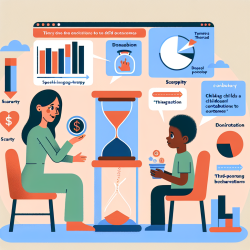Improving Online Therapy Services through AI Insights from Arctic Sea Ice Forecasting

In a world increasingly driven by data and technology, the field of online therapy is no exception. TinyEYE, a leader in providing online therapy services to schools, can benefit from cutting-edge research in seemingly unrelated fields. One such area is the groundbreaking study titled "Seasonal Arctic sea ice forecasting with probabilistic deep learning," which showcases the power of AI and deep learning in making accurate predictions. This blog will explore how practitioners in online therapy can leverage insights from this research to enhance their skills and encourage further exploration.
Harnessing AI for Enhanced Predictive Capabilities
The study introduces IceNet, a probabilistic deep learning system that forecasts Arctic sea ice with unprecedented accuracy. IceNet's ability to outperform traditional physics-based models highlights the potential of AI in predictive analytics. For online therapy practitioners, this translates into opportunities for improving predictive capabilities in client outcomes, therapy needs, and resource allocation.
Key Takeaways for Online Therapy Practitioners
- Data-Driven Decision Making: Just as IceNet uses historical and simulation data to predict sea ice changes, online therapy services can employ data analytics to anticipate client needs, monitor progress, and adjust therapy plans in real-time.
- Enhanced Accuracy: The probabilistic nature of IceNet allows it to express confidence levels in its predictions. Similarly, therapists can use AI tools to gauge the likelihood of various therapy outcomes, enabling more personalized and effective treatment plans.
- Efficiency and Scalability: IceNet’s rapid processing capabilities, which allow it to run thousands of times faster than traditional models, can inspire the development of AI tools that streamline administrative tasks, freeing up more time for direct client interaction.
Encouraging Further Research
The success of IceNet underscores the importance of interdisciplinary research and collaboration. Online therapy practitioners are encouraged to delve into AI and deep learning studies to discover new methods for improving therapy outcomes. Here are some steps to get started:
- Stay Informed: Regularly read research papers and articles on AI advancements. Platforms like Google Scholar and PubMed are excellent resources.
- Collaborate with Data Scientists: Partnering with experts in AI and data science can lead to innovative solutions tailored to the unique challenges of online therapy.
- Participate in Workshops and Conferences: Attend events focused on AI in healthcare and education to network with professionals and gain insights into the latest trends and technologies.
Conclusion
The insights from the study on Arctic sea ice forecasting with probabilistic deep learning offer valuable lessons for online therapy practitioners. By embracing data-driven decision-making, enhancing predictive accuracy, and encouraging interdisciplinary research, TinyEYE can continue to lead the way in providing exceptional online therapy services. To read the original research paper, please follow this link:
Seasonal Arctic sea ice forecasting with probabilistic deep learning.
Citation: Andersson, T. R., Hosking, J. S., Pérez-Ortiz, M., Paige, B., Elliott, A., Russell, C., Law, S., Jones, D. C., Wilkinson, J., Phillips, T., Byrne, J., Tietsche, S., Sarojini, B. B., Blanchard-Wrigglesworth, E., Aksenov, Y., Downie, R., & Shuckburgh, E. (2021). Seasonal Arctic sea ice forecasting with probabilistic deep learning. Nature Communications, 12, 5124. https://doi.org/10.1038/s41467-021-25257-4










